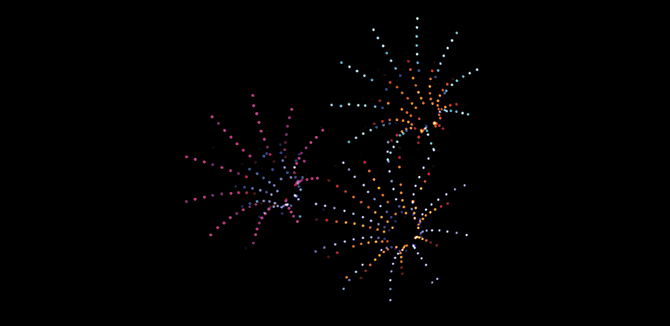Delving Into Drones
MEM students work with Evanston Fourth of July Association to research the possibility of replacing the annual fireworks display with a safer, more environmentally friendly alternative.

A trio of students in Northwestern's Master of Engineering Management (MEM) program have an idea to deal with the reality that the booms and blasts of a Fourth of July fireworks display cover up some nasty truths about the rockets’ red glare.
Vinayak Talikoti (MEM ‘23), Akhil Nair (MEM ‘23), and Kusuma Panguluri (MEM ‘23) collaborated with the Evanston Fourth of July Association to explore the possibility of replacing the annual explosion extravaganza with what is becoming a more popular alternative around the globe – a coordinated drone show.
The research idea started as a side project for the trio before transitioning into a for-credit independent project that relied heavily on what the students learned during their time in the MEM program.
“This project gave us a platform to implement the theories learned in class,” Talikoti said. “We perceived this project as a socio-behavior study, but our MEM degree made us realize the importance of data. Any study backed with data has more credibility.”
The biggest piece of new data the students added to the study of fireworks displays came from an investigation into the carbon dioxide emissions released during a typical Fourth of July event. The trio’s research determined a 20-minute fireworks display gives off the same amount of carbon dioxide as 1,221 cars traveling one mile through the city of Evanston, home to Northwestern University.
By comparison, the research found the drones necessary for a coordinated show give off less than 5 percent that amount over their entire lifespan of regular use.
This research tops the more anecdotal inconveniences of fireworks displays to bolster the case for switching to drones. These include:
- Fireworks’ one-time-only use
- The debris left over post-explosion
- The need for firefighters and emergency personnel to be on hand to deal with any unplanned incidents
- The distress the booms cause to those with war-related post-traumatic stress disorder and to pets
- The injuries associated with fireworks use, which tallied roughly 10,200 in 2022, according to the U.S. Consumer Product Safety Commission
The drone-show alternative is growing in popularity. In 2023, cities such as Boulder, Colo., and Salt Lake City, made the switch. The 2020 Tokyo Olympics, held in 2021, featured a display of 1,800 coordinated drones during its opening ceremonies.
Talikoti said the team’s research found the costs of a drone show comparable to that of a fireworks display.
“The direct cost of conducting a drone show is almost the same as fireworks but without any associated indirect cost for the city like firefighting or an ER response team,” he said. “Plus, there’s the reusability. Drones can be used multiple times.”
The Evanston Fourth of July Association currently is considering the MEM students’ findings but has yet to announce whether it will switch to drones in 2024. The trio recommended a follow-up study to gauge how the residents of Evanston would react to a drone show instead of a fireworks display.
Talikoti said he was happy with how the team’s work was received.
“The novelty of drones with various formations in the sky is that it’s visually appealing to the crowd and it can be coordinated with a symphony,” he said. “The committee accoladed our findings, especially on the environmental effects of fireworks and the disturbance caused to people with PTSD and pets.”

